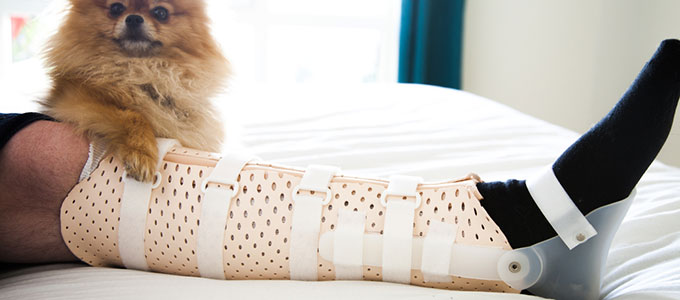
Problem
There are essentially three main types of fractures. The first is traumatic fracture from a definite injury. Patients always ask if the bone is cracked, broken, or fractured. If I say the bone is fractured, many times a patient will say, "Oh, thank goodness. I′m glad it wasn′t broken." In reality, there is no reason for relief. These terms all mean the same thing. If the fracture is in line and in place, a physician generally will not have to set it or move it into the correct alignment. If it is out of line, the physician will have to correct it to the prescribed alignment. Occasionally, this cannot be done by conservative means (by hands alone), and the patient has to be taken to surgery for anesthesia and a closed reduction (closed meaning no incision) or an open procedure (meaning an incision is necessary) so that the bones may be directly realigned. The bones about the knee are often pinned, screwed, or plated.
A second type of fracture is a stress fracture, which is caused by overloading. The most common stress fracture about the knee occurs in the proximal, or upper, shinbone. This condition may be termed a "march" or "fatigue" fracture. The term comes from the long marches required of new military recruits. Unused to long-distance marches, their leg (tibia) or foot (second metatarsal) bones are soon overloaded. A small microscopic fracture starts and is propagated with every footstep. Eventually this fracture can become quite painful.
The treatment for stress fractures consists of activity changes, allowing time to pass, bracing, and sometimes requiring the use of crutches. Some stress fractures do not heal well, and electrical stimulation may be necessary. It is unusual to have to do surgery or bone grafting to a stress fracture. Tibial stress fractures may require four months to heal, and only then can an athlete run and pound hard on the leg.
An avulsion fracture, the third type of fracture, typically occurs in children. The muscles pull on the tendons, and the tendons are attached to the bone. Many times this bony attachment is not solid because of a growth plate, the flat structure from which a bone grows. Since bones grow from these plates, they are not solid, and these attachment areas are somewhat weak. If there is an abrupt pull, such as one caused from simple jumping, sometimes the force may avulse, or pull off, a piece of bone. If the bone remains relatively close to its original position (for instance, let′s say within less than a half inch), we may treat it with a cast or brace. If it has pulled off farther, we may have to reduce it by repositioning the bone without an incision while the patient is anesthetized, or by pinning or screwing the area back. Such was the case with an Olympic gymnast who jumped very hard and pulled off her tibial tubercle growth plate.
This is a section from Dr. Jack E, Jensen′s book The One Stop Knee Shop. Read the next section Tumors.


